INTRODUCTION
Children aged <2 years are particularly susceptible to epidemic respiratory tract infections such as respiratory syncytial virus (RSV) bronchiolitis [Reference Deshpande and Northern1]. This usually benign disease is mainly managed on an outpatient basis. Inpatient management, particularly in paediatric intensive care units (PICUs) is required for the most severe forms of bronchiolitis. The hospitalization rate for RSV bronchiolitis is estimated at between 2% and 3% of the population of children aged <1 year [Reference Hall2, Reference Leader and Kohlhase3], and 2–3% of children hospitalized for RSV-related diseases are admitted to a PICU [Reference Deshpande and Northern1]. Some children are at a high risk of hospitalization for RSV infections: preterm infants, especially those with bronchopulmonary dysplasia (BPD); infants with haemodynamically significant congenital heart disease, cystic fibrosis, immunodepression, congenital airway abnormalities, and neuromuscular diseases [4]. These children should receive general prevention designed to reduce exposure to RSV [4] and some may also benefit from specific immunoprophylaxis [4].
Recent literature reports an increase in the incidence of bronchiolitis and in bronchiolitis hospitalization rates, as well as more severe episodes of bronchiolitis in some countries [Reference Deshpande and Northern1, Reference Grimprel5]. In France, there is a lack of information on the epidemiology of bronchiolitis [Reference Grimprel5]. In this context the use of the French national registry of hospitalizations (i.e. Programme de Médicalisation des Systèmes d'Information; PMSI) as a relevant database for epidemiological studies on bronchiolitis can be questioned. Even though the PMSI was initially created to assess the activity of hospitals for economic purposes on a national basis, it has been used for epidemiological studies in various medical fields.
Therefore the primary objective of this study was to conduct a retrospective survey to describe the population of children admitted to PICUs for bronchiolitis during the 2005–2006 RSV season in France and to record the outcome. The secondary objective was to assess the concordance between PMSI data and this retrospective data record.
METHODS
A survey was performed in 2008 on the RSV season from 1 October 2005 to 30 April 2006. It was designed to include all children aged <2 years hospitalized in a PICU for bronchiolitis.
Data were collected retrospectively from medical files by sending questionnaires to the 49 French PICUs (metropolitan France and overseas departments and territories). Data from the PMSI database for the same period were studied.
Retrospective data collection
The questionnaire had to be completed for each child admitted to a PICU for bronchiolitis during the RSV season. The questionnaire concerned neonatal history and the episode of bronchiolitis. The collected variables are presented in Table 1.
Table 1. Characteristics of hospitalizations for bronchiolitis in: (i) 24 French PICUs (season 2005–2006), according to the mode of data collection (retrospective survey and ADS of the national PMSI database); (ii) all French PICUs according to the PMSI database
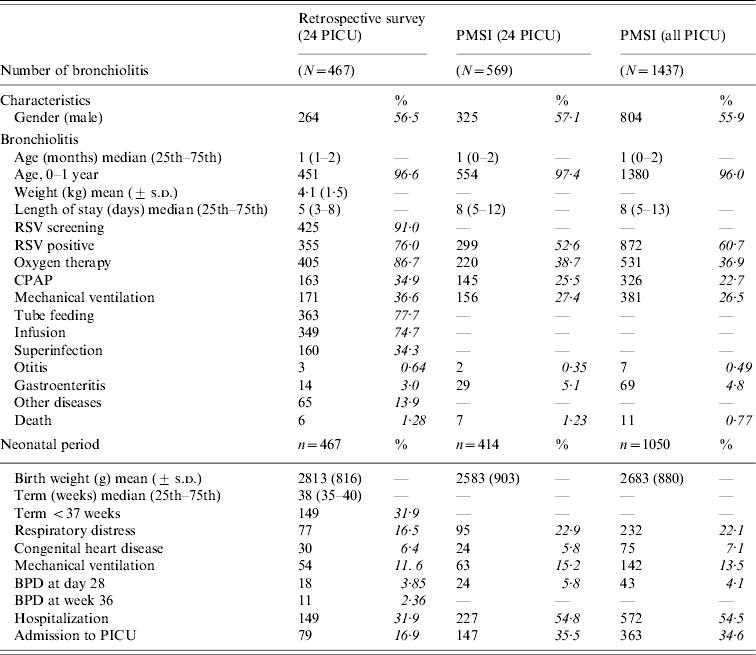
ADS, Anonymous discharge summary; BPD, bronchopulmonary dysplasia; CPAP, continuous positive airway pressure; PICU, paediatric intensive care unit; PMSI, Programme de Médicalisation des Systèmes d'Information; RSV, respiratory syncytial virus.
Recording of hospitalizations in the PMSI national database
All hospitalizations for bronchiolitis during the 2005–2006 RSV season were identified in the PMSI national database provided by the Agency for Information on Hospital Care (ATIH), after specific approval from the French Computers and Privacy Commission had been obtained (Commission Nationale Informatique et Liberté No. 1218552).
Each hospital stay was identified by an anonymous discharge summary (ADS), defined by an anonymized record of medical and administrative information.
Identified stays were classified into two groups, according to the type of bronchiolitis:
• RSV bronchiolitis: ADS comprising a main, related or associated diagnosis, coded ‘J210’, the code for ‘acute bronchiolitis due to respiratory syncytial virus’ in the tenth version of the International Classification of Diseases (ICD-10).
• ‘Other’ bronchiolitis: code ‘J218’ (acute bronchiolitis due to other specified organisms) or ‘J219’ (acute bronchiolitis, unspecified) in the main, related or associated diagnosis.
ADS for which the main, related or associated diagnosis did not correspond to bronchiolitis were excluded from the analysis.
Two types of hospitalization were identified according to coding rules of the Methodological Guide for the production of summaries of stay [6], given by the ATIH:
• Admission to an intensive care unit.
• Admission to another unit: the medical unit was of another type or was not specified.
Data linking
Linking the neonatal period to the episode in the PMSI database
Data linking was performed in order to attribute to each child with bronchiolitis the corresponding ADS of his neonatal period.
Data were linked by using the anonymous number generated for each patient by a Named-Patient Information Masking Function [Reference Quantin7].
Hospital stays comprising an identical anonymous number were therefore pooled, allowing the reconstitution of the patient's hospital trajectory.
Two modes of data collection for PICU admissions
Each hospitalization identified in data collected retrospectively from PICU records had to be present in the PMSI anonymous database. In such cases, the datasets for the two hospitalizations comprising identical information, i.e. the child's gender, the month and year of discharge, and the length of stay, for the same establishment were linked. This data linking was performed manually for each child.
The concordance between the two modes of data collection, for hospitalization data and the neonatal period could therefore be tested.
Statistical analyses
Descriptive analyses
Qualitative variables were described as percentages. Quantitative variables were described by their means and standard deviations and their medians, and 25th and 75th percentiles for variables with a non-normal distribution.
The characteristics of the children managed with or without mechanical ventilation were compared by univariate analysis (χ2 test) and the independent risk factors for mechanical ventilation were sought by multivariate analysis (logistical regression). A similar study was performed for children treated with or without continuous positive airway pressure (CPAP).
Concordance tests
Concordance was measured between the retrospective dataset and the PMSI datasetFootnote † when data linkage was possible.
Concordance between the two modes of data collection was estimated by the kappa coefficient for qualitative variables and the intra-class correlation coefficient (ICC) for quantitative variables [Reference Landis and Koch8]. Concordance was considered excellent for ICC or kappa coefficients between 1 and 0·80; good for ICC or kappa coefficients between 0·80 and 0·60; moderate for ICC or kappa coefficients between 0·60 and 0·40 and poor for ICC or kappa coefficients <0·40 [Reference Landis and Koch8]. All hypotheses were tested at the alpha risk of 0·05. Data analyses were performed with SAS 8.2 software (SAS Institute Inc., USA).
RESULTS
Twenty-five PICUs (51·0% of the contacted units) returned the questionnaire; one unit was excluded, as its dataset represented the 2007–2008 epidemic season. A total of 24 PICUs and 467 children admitted to PICUs were finally included in the study.
The characteristics of the children admitted for bronchiolitis were described for the two modes of data collection (see Table 1).
Characteristics of children admitted to a PICU for acute bronchiolitis (data from retrospective collection)
Seventy-five per cent of children admitted to the 24 PICUs of the study during the 2005–2006 RSV season were aged ⩽2 months, and almost all (n=451) were aged <1 year.
Three hundred and fifty-five children (76%) were positive for RSV (RSV screening was performed in 91% of the study sample).
Four hundred and five children (86·7%) received oxygen therapy (mean duration 4·5±3·6 days, median 3·0 days), 34·9% received CPAP alone or with mechanical ventilation (3·6±2·2 days, median 3·0 days), 36·6% received conventional or high frequency oscillation (HFO) mechanical ventilation (5·5±4·1 days, median 5·0 days).
Six deaths (1·3%) were reported. No information on the neonatal period was available for one child who died. The neonatal characteristics of the other five deaths were as follows:
• All were males. The birth weight was 2716 g (±941 g) and the median gestational age (GA) was 38·5 weeks (range 35–40).
• During the neonatal period, these infants presented with the following conditions: three cases of neonatal respiratory distress, three cases of congenital heart disease (co-arctation of the aorta, n=2; abnormal implantation of the left coronary artery, n=1); one case of BPD.
Otherwise, the hospitalization characteristics of the six infants who died were as follows:
• The mean weight on admission for bronchiolitis was 4189±1777 g and the mean postnatal age was 92·2±100·6 days (13±14 weeks). RSV screening was positive for five children and a nosocomial infection was diagnosed in one child. Treatments included: CPAP (n=1), oxygen therapy (n=5), mechanical ventilation (n=5), tube feeding (n=3), and intravenous infusion (n=6). The clinical course was marked by two superinfections, one cardiac decompensation with probable myocardial infarction, one hypotension followed by cardiac arrest, and one acute respiratory distress syndrome with bilateral pneumothorax.
Of the 467 children hospitalized in a PICU for bronchiolitis, the characteristics of infants treated with or without mechanical ventilation were compared with univariate analysis (Table 2). The multivariate analysis identified only low gestational age as an independent risk factor for mechanical ventilation (P=0·0003).
Table 2. Univariate analysis of clinical characteristics associated with the use of mechanical ventilation (MV) for bronchiolitis treatment in 24 French PICUs (n=467)
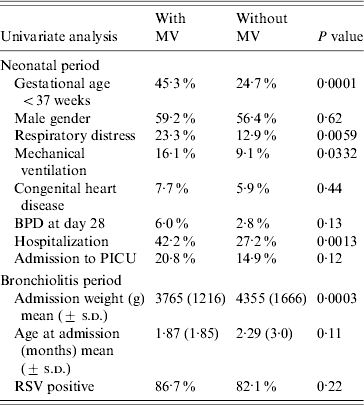
BPD, Bronchopulmonary dysplasia; PICU, paediatric intensive care unit; RSV, respiratory syncytial virus.
The characteristics of the children managed with or without CPAP were also compared with univariate analysis (Table 3). The multivariate analysis identified only RSV positivity (P=0·0289) as an independent risk factor for CPAP. CPAP tended to be used less frequently in the presence of congenital heart disease (P=0·0573).
Table 3. Univariate analysis of clinical characteristics associated with the use of continuous positive airway pressure (CPAP) for bronchiolitis treatment in 24 French PICUs (n=467)
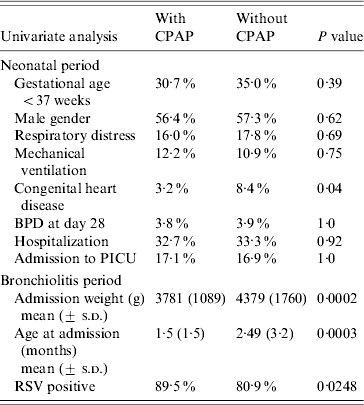
BPD, Bronchopulmonary dysplasia; PICU, paediatric intensive care unit; RSV, respiratory syncytial virus.
Characteristics of the neonatal period (data from retrospective collection)
One hundred and forty-nine (31·9%) children were born before term (GA <37 weeks); 26·8% were born at GA ⩽36 weeks; 12·2% were born at GA ⩽33 weeks and 5·3% were born at GA ⩽31 weeks. Nine (16·5%) children were small for their gestational age (SGA) at birth [Reference Ferdynus9].
About 16·5% of the children had experienced an episode of neonatal respiratory distress, and 11·6% of these required mechanical ventilation during the neonatal period. BPD at day 28 of life and BPD at week 36 of post-conceptional age were identified in 3·8% and 2·4% of cases, respectively.
Congenital heart disease was reported in 30 (6·4%) children: nine cases of ventricular septal defect, either isolated or associated with other anomalies; six of atrial septal defect, either isolated or associated with other anomalies; four of co-arctation of the aorta; two of atrioventricular septal defect; two cases of surgically closed patent ductus arteriosus, two of cardiomyopathy; two of valvular heart disease, and one case of abnormal implantation of the coronary artery. The type of heart disease was not specified in two cases.
Concordance between retrospective data collection and the PMSI database
Monthly prevalence of intensive care admissions for bronchiolitis
Figure 1 shows the monthly prevalence of PICU admissions for bronchiolitis according to the retrospective dataset and the corresponding PMSI database.
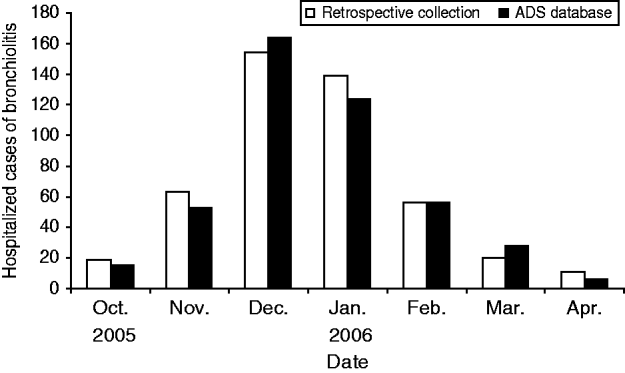
Fig. 1. Monthly prevalence of paediatric intensive care admissions for bronchiolitis in 24 PICUs according to the mode of data collection (retrospective and ADS of the national PMSI database).
Concordance for the episode of bronchiolitis (Table 4)
Data retrospectively collected from patients' files in the PICUs were considered the reference values.
Table 4. Concordance between PMSI and a restrospective data collection for characteristics of the episode of bronchiolitis (study based on the 330 cases of the retrospective dataset that could be linked to the corresponding ADS of the PMSI database)
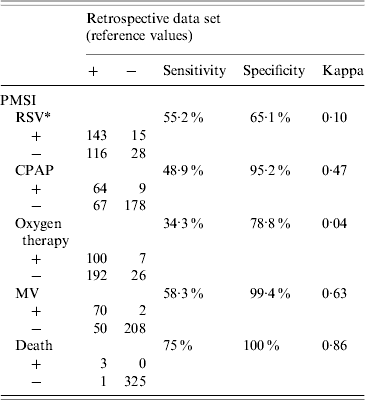
ADS, Anonymous discharge summary; CPAP, continuous positive airway pressure; MV, mechanical ventilation; PMSI, Programme de Médicalisation des Systèmes d'Information; RSV, respiratory syncytial virus.
* 302 cases were tested for in the retrospective dataset.
Of the 467 cases reported in the retrospective data collection, it was possible to link 330 (70·7%) to the ADS of the PMSI database (Table 4):
• Of the 330 children admitted to a PICU in the retrospective data collection, 71·1% were coded in the PMSI as having been admitted to a PICU.
• Two hundred and fifty-nine of these 330 children had a positive diagnosis of RSV (78·5%) on retrospective data collection, but PMSI identified only 143 (55·4%) of these 259 cases, coded as ‘RSV bronchiolitis’. The remaining 116 (44·8%) cases were coded as ‘acute bronchiolitis due to other specified organisms’ or ‘acute bronchiolitis, unspecified’.
Of the 43 RSV-negative cases identified on retrospective data collection, 15 (34·9%) were identified in PMSI as RSV-positive (‘RSV bronchiolitis’) and another 28 (65·1%) were coded ‘acute bronchiolitis due to other specified organisms’ or ‘acute bronchiolitis, unspecified’.
The kappa coefficient between the two datasets was 0·10 for positive RSV screening.
• One hundred and twenty of the 330 children (36·4%) were treated by mechanical ventilation according to retrospective data collection, but only 70 (58·3%) were correctly identified in the PMSI. Of the children not treated by mechanical ventilation, 208 (99·4%) were correctly identified in the PMSI. The kappa coefficient between the two datasets was 0·63 for mechanical ventilation.
The kappa coefficients for death, CPAP and oxygen therapy were 0·86, 0·47 and 0·04, respectively.
Concordance for the neonatal period
Of the 330 ADS corresponding to the current episode, it was possible to link 225 (68·6%) to the ADS of the corresponding neonatal period. Concordance between retrospective data collection and the PMSI database for the neonatal period were therefore tested on these 225 cases (Table 5). The kappa coefficients for BPD at day 28, mechanical ventilation, hospitalization rate, respiratory diseases and congenital heart diseases were 0·69, 0·63, 0·47, 0·49 and 0·45, respectively.
Table 5. Concordance between PMSI and a retrospective data collection for characteristics of the neonatal period (study was based on the 225 cases of the retrospective data for which the neonatal period could be linked to the ADS of the corresponding PMSI)
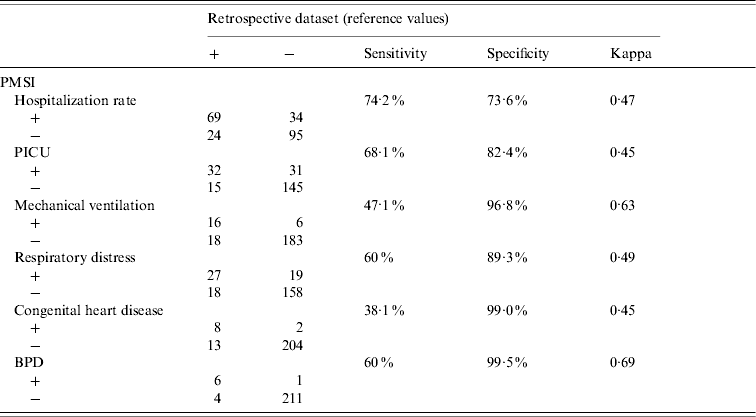
ADS, Anonymous discharge summary; BPD, bronchopulmonary dysplasia; PMSI, Programme de Médicalisation des Systèmes d'Information; PICU, Paediatric intensive care unit.
An excellent ICC between the two datasets was observed for birth weight (ICC=0·87; not shown in Table 5).
DISCUSSION
This study has shown that the most severe form of bronchiolitis is observed in young infants (aged <3 months) with a past history of neonatal diseases and that these infections are usually due to RSV.
The mortality rate in children with bronchiolitis admitted to a PICU was 12·8/1000 in this retrospective dataset of 467 infants. A recent prospective study conducted in Switzerland analysed 462 paediatric intensive care admissions for RSV lung infection (89% aged <1 year) and reported a mortality rate of 11·6/1000 [Reference Berger10]. This mortality rate is lower than rates described in the USA, UK, Canada and Israel with values ranging from 17·0 to 42·0/1000 for hospitalizations for RSV infections [Reference Feltes11–Reference Prais, Schonfeld and Amir15]. Some explanations for these differences may be put forward, particularly the wide variations in severity of viral bronchiolitis in the different seasons, variations in disease severity between different countries during the same season [Reference Grimaldi, Cornet and Milou16, Reference Eriksson17], and different proportions of high-risk infants admitted to a PICU.
Compared to another population of French infants (Perinatal Network of Burgundy, years 2005–2006, unpublished data), this population was characterized by low birth weight (2813±816 g vs. 3240±534 g) and high rates of prematurity (31·9% vs. 6·6%), neonatal respiratory distress (16·5% vs. 4·9%), mechanical ventilation (11·6% vs. 1·3%), BPD at day 28 (3·9% vs. 0·3%), congenital heart disease (6·4% vs. 1·0%), neonatal hospitalization (31·9% vs. 11·2%) and admission to a PICU (16·9% vs. 1·9%). These data fit well with another regional French study [Reference Grimaldi, Cornet and Milou16] which identified neonatal respiratory distress, preterm birth <32 weeks and congenital heart disease as perinatal risk factors for hospitalization in a PICU for bronchiolitis. When the analysis was restricted to the population of children admitted during the first year of life, our results were similar to those recently reported in Switzerland [Reference Berger10] especially for preterm birth <35 weeks (20·7% in the present study vs. 22·7%), congenital heart disease (6·1% vs. 8%), and BPD (3·6% vs. 6·0%).
These results confirm that prevention of bronchiolitis should be focused on young infants especially those with a past history of neonatal disease.
Children admitted to a PICU for bronchiolitis were characterized by age <2 months (75%) and RSV infections (91%). The risk of mechanical ventilation for bronchiolitis (conventional/HFO) was increased by a past history of prematurity. With regard to another study from Israel [Reference Prais, Schonfeld and Amir15], the main characteristics of hospitalizations in a PICU were similar: the median age at admission (1·0 vs. 2·3 months); the rate of hospitalizations with mechanical ventilation (36·6% vs. 28·7%); the average duration of PICU stay (5·0 vs. 7·7 days) and the rate of admissions with a positive RSV diagnosis (83·5% vs. 81·4%).
Finally, our study revealed that a past history of respiratory distress syndrome and mechanical ventilation was significantly associated with the need for mechanical ventilation during bronchiolitis. Another Spanish study [Reference Hernando Puente18] also identified congenital heart disease as a perinatal risk factor for mechanical ventilation during bronchiolitis.
Therefore, a past history of severe neonatal respiratory disease or congenital heart disease is associated with the most severe form of bronchiolitis. In our series, infants who died of bronchiolitis presented with at least one of these perinatal conditions.
This retrospective study did not allow us to draw any conclusions about RSV prevention and RSV immunoprophylaxis because these items were not recorded with any reliability.
In the Swiss cohort of children admitted to a PICU for RSV infection only nine (1·9%) received specific prophylaxis. The rate was similar (2·8%) in another Spanish study [Reference Cilla19], in which 357 infants were hospitalized between 1996 and 2000 for severe bronchiolitis. In the present series, 3·2% of the children were eligible for RSV-specific prophylaxis according to the Guidelines of the French Paediatric Society (press release, 28 October 1999). This result is comparable to the rate of 3·7% observed in a French single-centre study conducted by Chevret et al. [Reference Chevret20]. According to the most recent guidelines of the American Academy of Pediatrics [4], 29·1% of this series should have been eligible for palivizumab prophylaxis. Therefore, the most severe forms of bronchiolitis are currently observed in infants who are not eligible for RSV-specific prophylaxis.
In cases of insufficient concordance between retrospective PICU data and PMSI data, the retrospective PICU data were considered the reference in order to assess the validity of the PMSI.
The PMSI sample in this study represented 39·6% of the 1437 paediatric intensive care stays identified in the national PMSI database. The PMSI overestimated the number of paediatric intensive care stays by 8·1% compared to the number recorded in the retrospective dataset. However, the PMSI appeared to provide a reliable estimate of the monthly admission rate to a PICU for bronchiolitis (Fig. 1). Indeed, the winter period of the RSV season appeared to be clearly identified by data recorded in the PMSI.
The calculation of concordance coefficients after linking the two datasets provided more precise information about PMSI validity. The concordance between PMSI data and retrospective data concerning the neonatal period was satisfactory (excellent or good) for a limited number of variables (birth weight, mechanical ventilation, BPD at day 28) and during the bronchiolitis episode (mechanical ventilation, death). Therefore, it can be highlighted that the overall PMSI data confirmed the low rate of mortality for bronchiolitis in France (7·7/1000, 95% confidence interval 3·8–13·6).
The information entered into the PMSI database did not identify admissions to a PICU for 31% of intensive care stays and presented poor concordance for variables essential for epidemiological studies on RSV, i.e. the proportion of cases of bronchiolitis due to RSV, the use of CPAP and oxygen for bronchiolitis treatment, and the past history of neonatal respiratory distress.
It is of note that this poor global concordance between PMSI and retrospective data was observed despite the similar percentages for certain variables such as congenital heart disease and CPAP, indicating that the variables identified by PMSI did not concern the same patients. Therefore, the PMSI cannot be used to conduct a reliable analysis of risk factors based on these variables.
CONCLUSION
Children admitted to a PICU for bronchiolitis are characterized by the generally accepted risk factors, particularly severe prematurity. Most children in this retrospective dataset were aged ⩽2 months, and although all were not tested for RSV, a large majority of cases with severe bronchiolitis were positive for RSV. However, the mortality rate was low in the context of practices during the 2005–2006 RSV season, which makes it a challenging endpoint for epidemiological or medico-economic studies designed to evaluate new bronchiolitis prevention strategies [Reference Hascoet21].
At the present time, the PMSI database cannot be used to conduct reliable epidemiological studies on bronchiolitis.
ACKNOWLEDGEMENTS
The Burgundy Perinatal Network thanks all of the paediatric intensive-care units that returned the retrospective questionnaire: CHR Lyon, CHRU Angers, CHRU Lille, CHU Nice, CHU Amiens, CHU Bordeaux, CHU Dijon, CH Côte Basque Bayonne, CHI Créteil, CHI Montreuil, CHR Toulouse, CHRU Rennes, CHU Limoges, CHU Besançon, CHU Caen, CHU Fort-de-France, CHU Montpellier, CHU St Etienne, G.H. Sud-Réunion (St Pierre), CHR Kremlin Bicêtre (AP-HP), PSPH Fondation Lenval (Nice), CHR Necker (AP-HP), CHR Robert Debré (AP-HP), and CHU Strasbourg.
This study was funded by a grant from Abbott Laboratories.
DECLARATION OF INTEREST
None.








